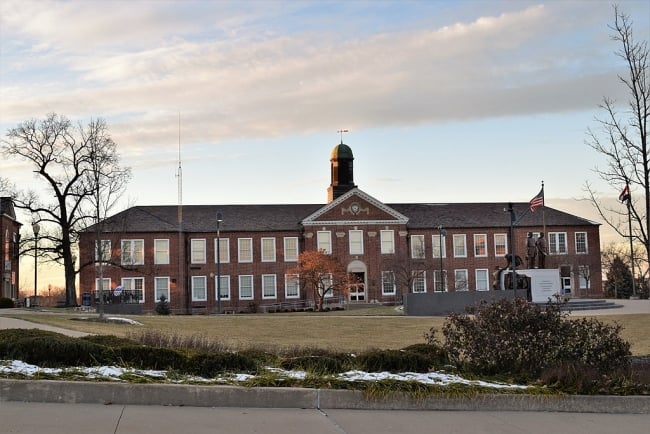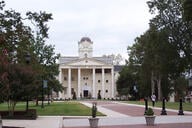You have /5 articles left.
Sign up for a free account or log in.

Young Hall at Lincoln University in Jefferson City, Mo.
TheCatalyst31/Wikimedia Commons
The Lincoln University Board of Curators decided Thursday to explore re-establishing a relationship with the university’s former foundation. The public historically Black university cut ties with its foundation just over two years ago after university officials became unhappy with the foundation’s performance and level of autonomy.
Lincoln University, located in Jefferson City, Mo., used to work with the Lincoln University Foundation, a private organization that has since changed its name to the 62nd & 65th Regiments Legacy Foundation. The university severed the relationship in December 2018 and moved all asset management and fundraising efforts in-house. The split resulted in dueling lawsuits that were consolidated and settled less than a year ago.
On Thursday, the Board of Curators expressed interest in rekindling that relationship, potentially benefiting both parties.
The foundation has raised between $8 million and $9 million to support Lincoln University students over the past several years. The university does not have direct access to those funds, Victor Pasley, president of the Board of Curators, said during an executive committee conference call.
On its own, the foundation has struggled to issue scholarships. It dispersed only $50,000 in scholarship funds for students this year -- a far cry from the $200,000 it dispersed annually while associated with the university.
“We've had a hard time letting students know who we are,” said Hardy Dorsey, president of the foundation's board. “It’s been troubling.”
The university’s desire to reconcile with its former foundation only a few years after parting ways -- and less than a year after a legal battle between the two institutions ended -- highlights the importance of the sometimes-strained but symbiotic relationships public universities have with external foundations.
The United States is home to 1,400 college and university foundations, according to the Council for Advancement and Support of Education. About 500 of those organizations support public universities, while the remaining 900 support community colleges.
Unlike the institutions they support, the foundations are private organizations. They primarily serve to manage private assets for colleges or universities and to sequester private money away from state interference, said Gene Tempel, a professor of philanthropic studies and founding dean emeritus at the Indiana University Lilly Family School of Philanthropy. A private foundation ensures that funds raised by the university are used in the way donors intended them to be used.
“The foundation makes sure that those funds aren’t just swept up by the state, or, let’s say the state looks at the amount of private funds the university has raised and then deducts that amount from its appropriation,” Tempel said.
Most public universities have healthy tension with their associated foundations, Tempel said.
“There’s input coming from the foundation and there’s input coming from the donors, and the university has to try to deal with that,” Tempel said.
On the other hand, universities may believe foundations can do things that they can't, like hand over unrestricted funds.
It’s very unusual for those tensions to grow big enough to result in a split, but Lincoln is not the first university to part ways with its foundation.
The University of Georgia broke up with its foundation in 2005 after conflicts between the two came to a head. The rift between the two organizations began when Michael Adams, who was university president at the time, decided not to renew the contract for former athletics director Vince Dooley, a popular former head football coach. Then the foundation audited Adams’s compensation and spending from foundation funds and threatened to cut its contribution to Adams’s salary.
The University of Georgia has since created a new foundation to replace the old one, Tempel said. He’s encouraged that Lincoln University is considering reviving its affiliation with the 62nd & 65th Regiments Legacy Foundation.
“It’s good here to see that they're trying to get this thing back together,” he said.
Lincoln University announced in February 2019 that it had parted ways with the foundation.
“The University has decided to move in a new direction consistent with best practices in higher education fundraising to assure the most effective and efficient use of donated funds,” Misty Young, a spokesperson for the university, wrote in a press release at the time.
Dorsey said the conflict grew from the Lincoln University president’s request to appoint members to the foundation board.
“She wanted 10 people on the board,” he said. “We said no.”
Five months after the university voided its memorandum of understanding with the foundation, the foundation sued the university and asked the court to order the university to return all foundation documents, information and assets, including more than $667,000 in foundation special-purpose funds, the News Tribune reported.
At the time, Young told the News Tribune that the university was “surprised and disappointed” that the foundation sued the university.
The university responded with a lawsuit of its own, and the two suits were later consolidated into one at the foundation’s request. The two organizations reached a settlement in June 2020. In it, the foundation agreed to “hold in trust and administer” 51 scholarship funds and 85 endowment funds and said it would not use the university’s name, symbols, logos, marks and seals. The university was required to help students attain scholarships from the foundation.
On Thursday, the Board of Curators passed a resolution to form a committee to explore re-establishing a relationship between the university and the foundation.
“The committee shall be given authority to explore a re-affiliation and, if considered advisable, develop an agreement between Lincoln University and the former Lincoln University Foundation, acceptable to both organizations, for consideration and approval by the Board of Curators,” the motion said.
The committee will include board chair Pasley, university president Jerald Jones Woolfolk and board members Richard Callahan and Everidge Cade Jr.
Not everyone on the Board of Curators is gung-ho about mending the university-foundation relationship. Several board members expressed doubts during Thursday’s meeting.
Curator Frank Logan worried that the board was overstepping its authority by creating the committee and wondered about potential consequences for the university’s accreditation.
“This motion is troubling on many fronts,” Logan said. “I have stated in the past that the Board of Curators has a responsibility for university governance. This action that you are trying to take is an administrative action, which is again beyond the scope of what this board is constituted to do. Two, we have heard from the local staff person who represents the university on the accreditation organization that said, ‘Affiliation would jeopardize our accreditation.’”
Curator Don Cook Sr.’s comments revealed that past wounds over the university’s rocky split from the foundation have not fully healed.
“We have gone through arbitration, legal actions and a separation for this. We have spent a lot of money to come to a decision in terms of where we are today,” Cook said.
Dorsey said he’s eager to work with the Board of Curators to draft a new memorandum of understanding if it decides to do so.
“I am looking forward to working with the curators. I think there’s strength in synergy,” he said. “So I am really welcoming a healthy and constructive and productive relationship with the curators going forward and continue to expect that same relationship with our Alumni Association as well.”
If the board decides to work with the foundation again, it will likely draft a new memorandum of understanding. A memorandum is very important, said Brian Flahaven, vice president for strategic partnerships at CASE.
“The foundation only exists to support the institution. Everything they raise and they manage is to advance the mission of the institution,” he said. “That’s why alignment is obviously a pretty clear priority for both, and a memorandum really makes sure that alignment is happening.”
Memorandums don't hew to a one-size-fits-all template, Flahaven said. But some successful pieces appear again and again. For example, Flahaven suggests a university and foundation share some governing members.
“There's usually an overlap,” he said. “Most foundation boards have the institution president or a member of the institution’s governing board either as voting members of the board, or, a lot of times, ex officio members.”
If public universities seek to realize all the benefits from affiliating with a private foundation, Tempel stressed the importance of making clear that the university and foundation are two separate legal entities. Doing so protects donor information from becoming subject to sunshine laws, which in some states require a public institution’s information to be publicly available. He also recommends that universities and foundations draw up contracts for any services that flow between them.
Tempel warns against allowing a foundation to be too autonomous.
“The foundation acts only in the interest of the university,” he said. “It doesn't try to determine what the mission of the university is by what it funds. It only supports the university.”




